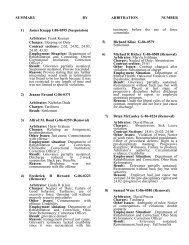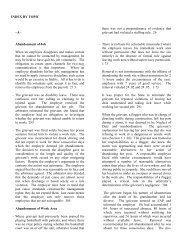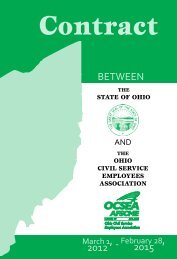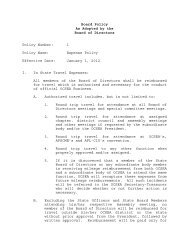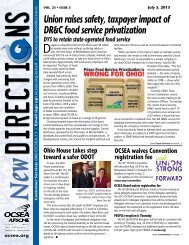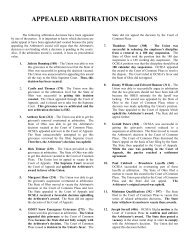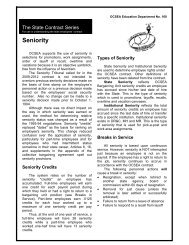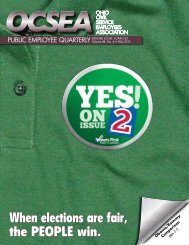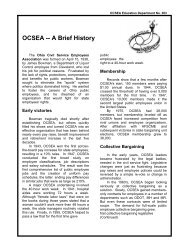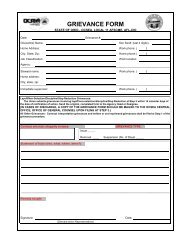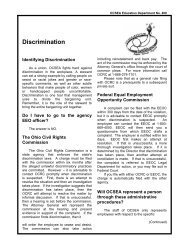by Contract Number (PDF) - OCSEA
by Contract Number (PDF) - OCSEA
by Contract Number (PDF) - OCSEA
You also want an ePaper? Increase the reach of your titles
YUMPU automatically turns print PDFs into web optimized ePapers that Google loves.
particularly in light of layoffs, bumping and<br />
transfers. 841<br />
The grievant sustained two injuries at work both<br />
in an attempt to restrain youths who refused to<br />
follow directives. The grievant followed the<br />
application process for OIL benefits. The<br />
employer presented photographs to show the<br />
grievant coaching football while on disability<br />
and receiving benefits. He was removed for<br />
filing false information on his application. The<br />
arbitrator concluded that the activity displayed in<br />
the evidence presented did not demonstrate that<br />
the grievant participated in strenuous activity<br />
similar to the activity required to perform his job<br />
at the youth facility. He did not come into<br />
physical contact with the players. The grievant’s<br />
injuries were due to the use of force with youths<br />
at the facility. No evidence was submitted to<br />
establish that the grievant submitted false data.<br />
842<br />
The grievant was charged with corresponding<br />
with an inmate and being dishonest about the<br />
relationship when interviewed. The arbitrator<br />
found that inconsistencies in the grievant’s two<br />
interviews raised questions about his<br />
trustworthiness. Although the arbitrator noted<br />
that the grievant appeared to be a compassionate<br />
person, his judgment and suitability as a<br />
Correction Officer was very doubtful. 843<br />
The grievant was responsible for making<br />
corrections to employees’ payroll records. The<br />
employer had a verbal work rule, which stated<br />
that employees were not permitted to make<br />
changes in their own accounts. The grievant was<br />
charged with deleting sixteen hours of leave<br />
usage from her balance. Computer records<br />
showed that the grievant’s user ID was used to<br />
make the deletions. At the time, the grievant was<br />
at her computer and logged on under her own ID<br />
and password. The arbitrator found the<br />
circumstantial evidence to be very strong against<br />
the grievant. The computer records, inconsistent<br />
statements, in addition to the grievants<br />
suspicious inquiry regarding whether a coworker’s<br />
ID would be the last to update the<br />
grievant’s account, discredit the grievant. The<br />
arbitrator concluded that the grievant more likely<br />
than not deleted the leave usages from her<br />
balance.The arbitrator stated, “When an<br />
employee who occupies such a position of trust<br />
engages in misconduct that is so strongly linked<br />
to the core of her duties, the bond of trust and<br />
confidence is permanently ruptured.” He opined<br />
that no measure of progressive discipline would<br />
likely renew the employer’s trust in the grievant.<br />
847<br />
The grievant was charged with violating several<br />
rules/regulations, mainly acts of insubordination.<br />
Instead of removal, the employer, the Union and<br />
the grievant were ordered to hold the discipline<br />
in abeyance pending completion of an EAP. The<br />
grievant was also moved to a new area with a<br />
new supervisor. The evidence showed that the<br />
grievant failed to comply with the agreement <strong>by</strong><br />
not maintaining contact with EAP. The<br />
arbitrator found the grievant’s “flat refusal to<br />
follow reasonable and proper directives and her<br />
blatant defiance of her supervisor’s<br />
authority…inexcusable.” The arbitrator noted<br />
that the minor violations alone were not serious<br />
but in totality with the continued pattern of<br />
insubordination they took on greater<br />
significance. He did not find sufficient evidence<br />
that the grievant clocked-in” for another<br />
employee. 848<br />
The grievant was a Training Officer with<br />
seventeen years of service with the State of Ohio,<br />
with an impeccable work record, no disciplines<br />
and several letters of commendation. He<br />
received information that a Parole Officer (PO)<br />
was driving on a suspended driver’s license from<br />
the PO’s partner (and friend of the grievant).<br />
This information originated via telephone to the<br />
PO’s partner from a Municipal Court<br />
Clerk/Police Officer. The PO’s partner did not<br />
wish to become involved and asked the grievant<br />
to relay the information to the proper people.<br />
When he took this information to the PO’s<br />
supervisor, he was advised to obtain and present<br />
proof of this allegation. The grievant contacted<br />
the Municipal Court Clerk/Police Officer who<br />
provided a LEADS printout to him. The<br />
grievant erased the key number from the printout<br />
in an attempt to protect the identity of the<br />
Officer. The employer contended that the<br />
grievant’s conduct involved unauthorized use,<br />
release or misuse of information, that he<br />
interfered with an official investigation and that<br />
his actions could prohibit a public employee<br />
from performing his/her duties. The Union<br />
argued that the PO’s supervisor’s advice to<br />
obtain proof of the allegation was an implicit<br />
authorization to do just that. The arbitrator<br />
determined that the employer did not establish<br />
proof of all of the alleged violations leveled<br />
against the grievant. The one violation<br />
established <strong>by</strong> the employer – erasing the key



